Five Blainville’s beaked whales (Mesoplodon densirostris) off the west coast of the island of Hawai‘i.
Almost a quarter of the 90 recognized species of cetaceans are beaked whales, members of the Family Ziphiidae. There are currently 23 recognized species, but several new species have been described in recent years and it is likely that more will be recognized as genetic analyses are undertaken on skeletal specimens and additional specimens are collected from stranded animals. Three species of beaked whales have been visually documented in Hawaiian waters – Cuvier’s beaked whale (Ziphius cavirostris), Blainville’s beaked whale, and Longman’s beaked whale (Indopacetus pacificus). We’ve encountered all three species in our work off the island of Hawai‘i, and have focused much of our research attention since 2003 on studying Cuvier’s and Blainville’s beaked whales. This has included studies of diving behavior, movements, habitat use, population size, and social organization. A number of publications and reports have resulted from this work – links to pdfs of these can be found at the bottom of this page
To learn more about the different species of beaked whales we’ve documented in Hawai‘i, you can select one of the quick links below:
Cuvier’s Beaked Whales | Blainville’s Beaked Whales | Longman’s Beaked Whales
Encounters with beaked whales in Hawai‘i are not frequent; on average we encounter beaked whales once every approximately five days of research effort. Based on our study Cuvier’s beaked whales are the seventh-most frequently encountered species of toothed whale in Hawai‘i. This species has the largest distribution globally, but our research with this species includes the longest-term photo-identification study anywhere in the world! Although we don’t see them very often, our long-term study of their ecology, behavior, habitat use, and population structure makes this population one of the most well-known for this species.
Cuvier’s beaked whales are most frequently confused with Blainville’s beaked whales when encountered. Download the above for information on how to distinguish between Cuvier’s and Blainville’s beaked whales.

An adult female Cuvier’s beaked whale surfacing near our boat, May 5, 2008, off the island of Hawai‘i. This individual, HIZc027 in our catalog, has been documented several times off the island over a span of more than 10 years. We are able to recognize individual beaked whales based on the unique patterning of scars on the back, as well as notches on the dorsal fin. Because of the large number of scars, photos from almost any angle can be used to identify individuals.
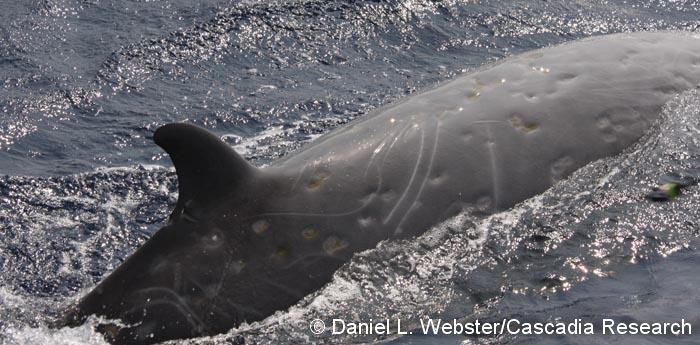
An adult male Cuvier’s beaked whale off Kona, December 2, 2008. We’ve seen this individual, HIZc044 in the catalog, on two previous occasions, in November 2006 and in May 2008, and most recently resighted it in December 2009. The linear scars on this individual are caused by fights with other male Cuvier’s beaked whales (only the males have erupted teeth), while the numerous oval scars/indentations are caused by cookie-cutter sharks.

An adult Cuvier’s beaked whale, April 28, 2009. This individual, HIZc041 in our catalog, was first documented off the island by Dan Mcsweeney in October 1994, and was seen again in July 2007 and on our December 2008 trip. It was also resighted again most recently in 2014 by one of our contributors, Deron Verbeck. Although the large amount of white coloration on the forward two-thirds of the body initially caused us to think it was an adult male (all adult males have extensive white on their bodies), the lack of linear scars from fighting with other males, and no visible teeth when the head was visible, indicates this individual is an adult female.
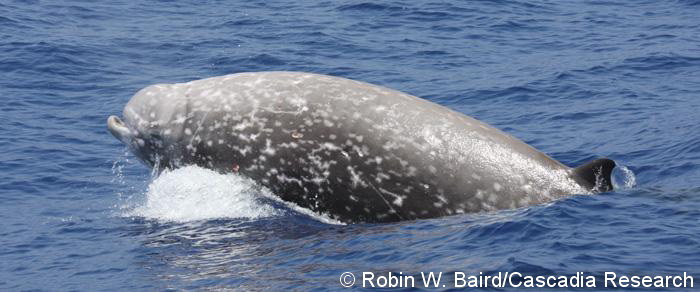
A Cuvier’s beaked whale with a deformed rostrum, HIZc062 in our catalog, seen on April 23, 2009. This whale is missing most of the upper jaw, although whether it is a congenital problem or from an injury is not clear from the photos. Based on the extensive white coloration this individual is an adult (see the 2007 paper by McSweeney et al. in Marine Mammal Science, available below). Based on the lack of erupted teeth in the lower jaw (only the teeth of males erupt from the gums), and the relative lack of tooth scars, this is an adult female, and was resighted twice in 2012. For more information on rostrum deformities in beaked whales, check out this paper by Dinis et al.
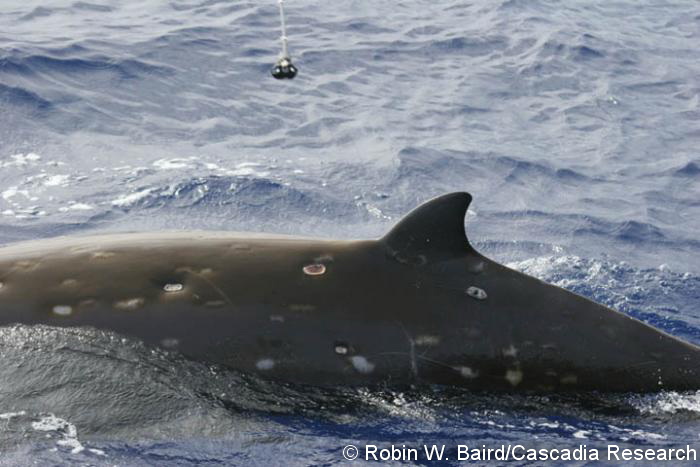
Adult female Cuvier’s beaked whale with satellite tag, HIZc027 in our catalog, immediately after tagging, May 5, 2008. This individual was first identified by us in 2005, and most recently resighted in 2017 by two of our contributors, Colin Cornforth and Shannon Harrison. The tag (gray in color with a black dot in the center) is visible just below and behind the fin. This individual also has a fresh wound from a cookie-cutter shark bite (in front of and below the fin) as well as numerous older scars from cookie-cutter shark bites. Information from these satellite tags is allowing us to assess movements outside of our study area.
Blainville’s beaked whales are the 10th-most frequently encountered species in our work off Hawai‘i. They were first identified off the islands in 1961 when two individuals stranded on Midway, although our study with this population didn’t begin until 2002. Between contributed photos and our own work, our photo-identification catalog for this species spans over 30 years, and includes 350 unique IDs, many of which have long-term resightings, indicating a resident population of this species off of Hawai‘i Island. We have also collected extensive data on habitat use for this species through satellite tag deployments – to date we have data from 19 deployments, four of which also recorded dive behavior!

An adult male Blainville’s beaked whale, HIMd155 in our catalog, seen on May 2, 2009. This individual has been resighted four times, once in 2015, twice in 2016 by contributors, and most recently in November 2018.
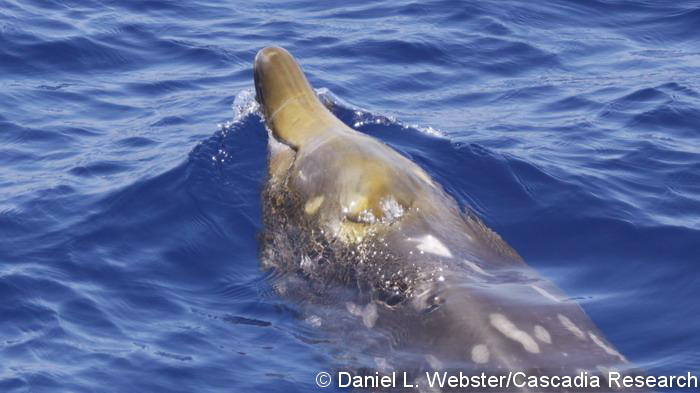
An adult female Blainville’s beaked whale, HIMd152 in our catalog, seen on April 29, 2009. In female Blainville’s beaked whales the teeth do not erupt from the gums and the lower law is relatively straight.
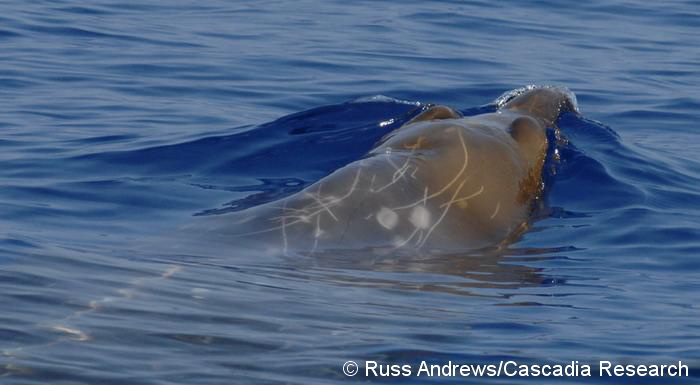
A sub-adult male Blainville’s beaked whale, HIMd154 in our catalog, seen on April 29, 2009. The two teeth of this individual have not yet erupted from the gums, as they do in adult males (see below), but the lower jaws are arching upwards, indicating a sub-adult male.

An adult male Blainville’s beaked whale, HIMd153 in our catalog, seen on April 29, 2009. The tips of the two teeth are visible above the gums – on the right tooth there are a number of purple stalked barnacles attached.
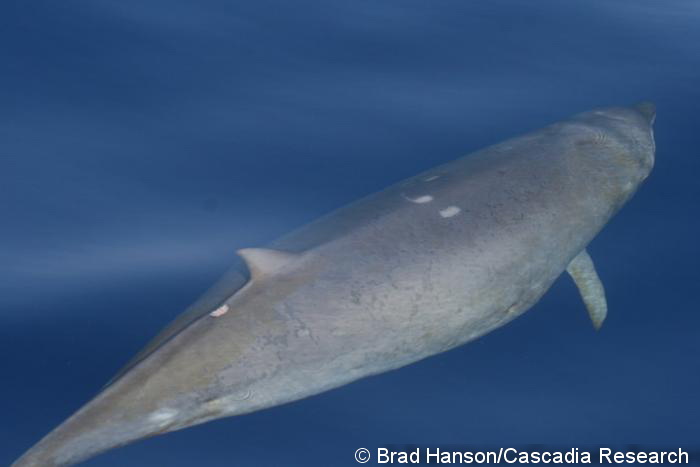
A juvenile Blainville’s beaked whale, HIMd147 in our catalog, seen on July 10, 2008. This animal has since been resighted 10 times, most recently in April 2021 by one of our contributors, Alex Lichtblau, and confirmed to be a male based on genetic analysis of a biopsy sample we took in December 2009.
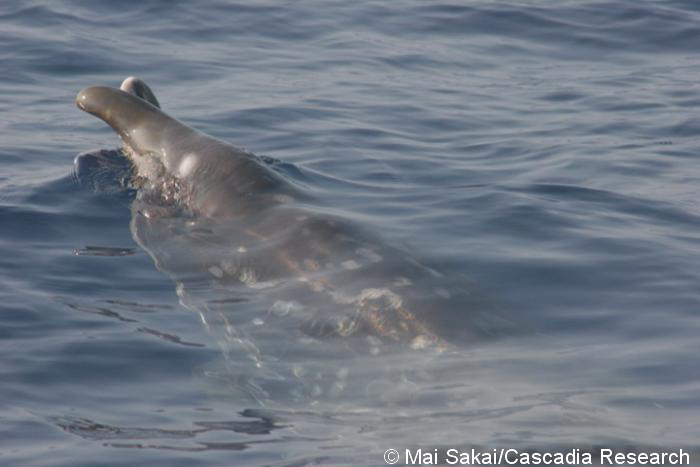
Adult female Blainville’s beaked whale (HIMd025) with a deformed rostrum, July 10, 2008. This individual has been seen 17 times off the island, with sightings spanning from 1991 to 2012. For more information about rostrum deformities in beaked whales, check out this paper by Dinis et al.
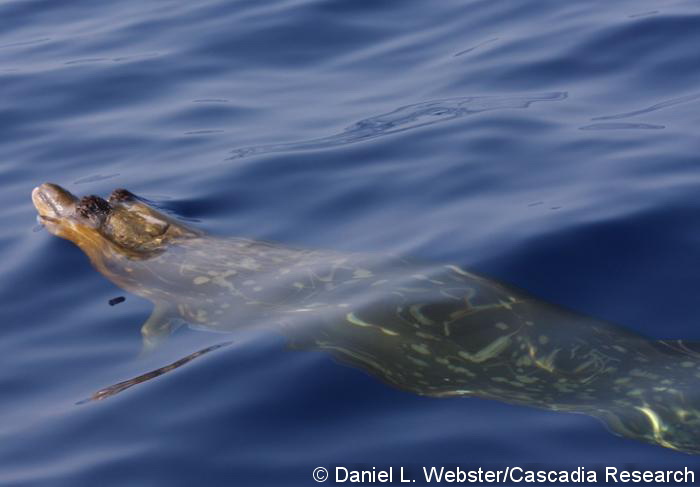
Adult male Blainville’s beaked whale (HIMd020), July 10, 2008. This individual has been documented once previously off Kona, in 2003. Blainville’s beaked whales are strongly sexually dimorphic in skull morphology, with a highly arched lower jaw and teeth that erupt in the middle of the jaw. In Hawai‘i the teeth are often covered in stalked barnacles (see close-up photo below). Male Blainville’s also have extensive linear scars on the head, from fighting with other males.

Close-up of the head of an adult male Blainville’s beaked whale (HIMd020), July 10, 2008. The teeth that are erupted from the lower jaw are covered in stalked barnacles, and thus are not visible. The brownish coloration covering most of the head are likely diatoms.

To examine movements and habitat use we are using remotely-deployed satellite tags with this species, like the one above, pictured at the moment of deployment onto HIMd285 in November 2017 off O‘ahu. More information on our satellite-tagging work with beaked whales can be found in this paper by Schorr et al., published in Endangered Species Research.

A juvenile Blainville’s beaked whale, HIMd147 in our catalog, breaching next to an adult female on July 10, 2008. Note the ventral throat grooves, characteristic of beaked whales. The brownish patches on the belly of this animal are likely diatoms.
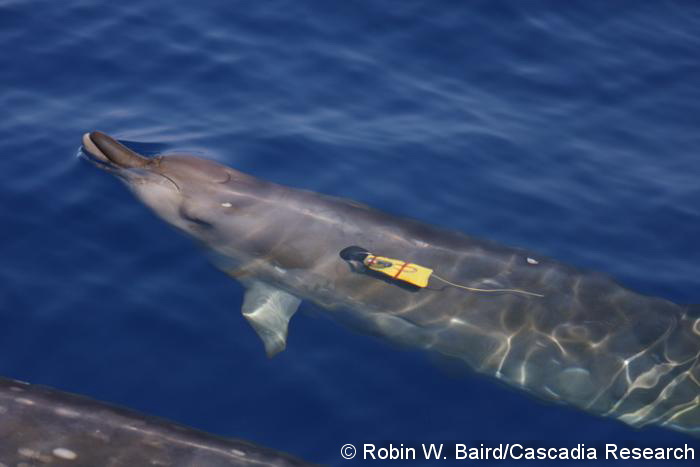
A juvenile Blainville’s beaked whale, HIMd149 in our catalog, with a suction-cup attached time-depth recorder, July 10, 2008. This tag remained attached for approximately 2 hours, during which time the whale made one long dive (45 minutes) to 829 m in depth. Based on the number of white oval scars (caused by cookie-cutter shark bites), we estimate this whale was 1-2 years of age.
Longman’s beaked whales are among the rarest species that we’ve encountered over the course of our fieldwork in the Hawaiian Islands. We’ve only had a single sighting with the species – a group of ~35 individuals in August 2007. In spite of this, there have been numerous likely reports of large groups Longman’s beaked whales off the island of Hawai‘i and in offshore waters around the Northwestern Hawaiian Islands, along with a single stranding in March 2010. While this species remains elusive for the moment, we hope to encounter them again in the future!
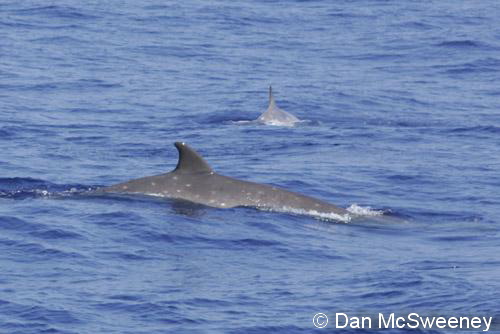
A Longman’s beaked whale (Indopacetus pacificus) off Kona.

A Longman’s beaked whale off Kona showing beak of one individual.
- Onoufriou, A.B., O.E. Gaggiotti, N. Aguilar de Soto, M.L. McCarthy, P.A. Morin, M. Rosso, M. Dalebout, N. Davison, R.W. Baird, C.S. Baker, S. Berrow, A. Brownlow, D. Burns, F. Caurant, D. Claridge, R. Constantine, F. Demaret, S. Dreyer, M. Ðuras, J. Durban, A. Frantzis, L. Freitas, G. Genty, A. Galov, S.S. Hansen, A.C. Kitchener, V. Martin, A.A. Mignucci-Giannoni, V. Montano, A. Moulins, C. Olavarría, M.M. Poole, C. Reyes, E. Rogan, C. Ryan, A. Schiavi, P. Tepsich, J. Urban, K. West, M.T. Olsen, and E.L. Carroll. 2022. Biogeography in the deep: Hierarchical population genomic structure of two beaked whale species. Global Ecology and Conservation. In press.
- Carroll, E.L., M.R. McGowen, M.L. McCarthy, F.G. Marx, N. Aguilar, M.L. Dalebout, S. Dreyer, O.E. Gaggiotti, S.S. Hansen, A. van Helden, A.B. Onoufriou, R.W. Baird, C.S. Baker, S. Berrow, D. Cholewiak, D. Claridge, R. Constantine, N.J. Davison, C. Eira, R.W. Fordyce, J. Gatesy, G.J.G. Hofmeyr, V. Martin, P.A. Morin, C. Reyes, E. Rogan, M. Rosso, M.A. Silva, M.S. Springer, D. Steel, and M.T. Oleson. 2021. Speciation in the Deep: Genomics and Morphology Reveal a New Species of Beaked Whale Mesoplodon eueu. Proceedings of the Royal Society B. 288: 20211213. Download PDF copy.
- Cioffi, W.R., N.J. Quick, H.J. Foley, D.M. Waples, Z.T. Swaim, J.M. Shearer, D.L. Webster, A.S. Friedlaender, B.L. Southall, R.W. Baird, D.P. Nowacek, and A.J. Read. Adult Male Cuvier’s Beaked Whales (Ziphius cavirostris) Engage in Prolonged Bouts of Synchronous Diving. Marine Mammal Science, 1-16. Available from Marine Mammal Science.
- Foley, H.J., K. Pacifici, R.W. Baird, D.L. Webster, Z.T. Swaim, and A.J. Read. 2021. Residency and movement patterns of Cuvier’s beaked whales Ziphius cavirostris off Cape Hatteras, North Carolina, USA. Marine Ecology Progress Series.
- Baird, R.W. 2019. Behavior and ecology of not-so-social odontocetes: Cuvier’s and Blainville’s beaked whales. Pages 305-329 in: Ethology and Behavioral Ecology of Toothed Whales and Dolphins, the Odontocetes. Edited by B. Würsig. Springer. Download PDF copy
- Mickey, S.T., R.W. Baird, and S.D. Mahaffy. 2019. Bite Me: Using Cookie-Cutter Shark Bite Scars to Estimate Age of Blainville’s Beaked Whales in Hawaiian Waters. Poster presented at the World Marine Mammal Conference, Barcelona, Spain, December 7-12, 2019. Download poster PDF
- Bernaldo de Quirós, Y., A. Fernandez, R.W. Baird, R.L. Brownell, N. Aguilar de Soto, D. Allen, M. Arbelo, M. Arregui, A. Costidis, A. Fahlman, A. Frantzis, F.M.D. Gulland, M. Iñiguez, M. Johnson, A. Komnenou, H. Koopman, D.A. Pabst, W.D. Roe, E. Sierra, M. Tejedor, and G. Schorr. 2019. Advances in research on the impacts of anti-submarine sonar on beaked whales. Proceedings of the Royal Society B. 286:20182533. Download PDF copy
- Hooker, S.K., N. Aguilar de Soto, R.W. Baird, E.L. Carroll, D. Claridge, L. Feyrer, P.J.O. Miller, A. Onoufriou, G. Schorr, E. Siegal, and H. Whitehead. 2019. Future directions in research on beaked whales. Frontiers in Marine Sciences doi.org/10.3389/fmars.2018.00514. Download PDF copy
- Shearer, J.M., N.J. Quick, W.R. Cioffi, R.W. Baird, D.L Webster, H.J. Foley, Z.T. Swaim, D.M. Waples, J.T. Bell and A.J. Read. 2019. Diving behavior of Cuvier’s beaked whales (Ziphius cavirostris) off Cape Hatteras, North Carolina. Royal Society Open Science 6:181728. Download PDF copy
- Baird, R.W. 2018. Cuvier’s Beaked Whale. In Encyclopedia of Marine Mammals. Edited by B. Würsig, J.G.M. Thewissen, K.Kovacs. 3rd edition. Elsevier Inc. Download PDF copy
- Dinis, A., R. W. Baird, S. D. Mahaffy, V. Martín, F. Alves. 2017. Beaked whales with rostrum deformities: Implications for survival and reproduction. Marine Mammal Science DOI: 10.1111/mms.12406. Download PDF copy
- West, K. L., W. A. Walker, R. W. Baird, J. G. Mead, P. W. Collins. 2017. Diet of Cuvier’s beaked whales Ziphius cavirostris from the North Pacific and a comparison with their diet world-wide. Marine Ecology Progress Series DOI: https://doi.org/10.3354/meps12214. Download PDF copy
- Forney, K.A., B.L. Southall, E. Slooten, S. Dawson, A.J. Read, R.W. Baird and R.L. Brownell Jr. 2017. Nowhere to go: noise impact assessments for marine mammal populations with high site fidelity. Endangered Species Research doi: 10.3354/esr00820 Download PDF copy
- Abecassis, M., J. Polovina, R.W. Baird, A. Copeland, J.C. Drazen, R. Komokos, E. Oleson, Y. Jia, G.S. Schorr, D.L. Webster, and R.D. Andrews. 2015. Characterizing a foraging hotspot for short-finned pilot whales and Blainville’s beaked whales off the west side of the Island of Hawai‘i with tagging and oceanographic data. PLOS ONE doi:10.1371/journal.pone.0142628. Download PDF copy
- Baird, R.W., D. Cholewiak, D.L. Webster, G.S. Schorr, S.D. Mahaffy, C. Curtice, J. Harrison and S.M. Van Parijs. 2015. Biologically important areas for cetaceans within U.S. waters – Hawai‘i region. Aquatic Mammals 41:54-64. Download PDF copy
- Mahaffy, S.D., R.W. Baird, D.J. McSweeney, D.L. Webster and G.S. Schorr. 2015. Group structure and mating strategies of Cuvier’s (Ziphius cavirorstris) and Blainville’s (Mesoplodon densirostris) beaked whales off the island of Hawai‘i. Poster presented at the 21st Biennial Conference on the Biology of Marine Mammals, San Francisco, California, December 14-18, 2015. Download PDF copy
- Foltz, K., R.W. Baird, G.M. Ylitalo and B.A. Jensen. 2014. Cytochrome P4501A1 expression in blubber biopsies of endangered false killer whales (Pseudorca crassidens) and nine other odontocete species from Hawai’i. Ecotoxicology. doi: 10.1007/s10646-014-1300-0. Download PDF copy
- Baird, R.W., D.L. Webster, S.D. Mahaffy, G.S. Schorr, J.M. Aschettino and A.M. Gorgone. 2013. Movements and spatial use of odontocetes in the western main Hawaiian Islands: results of a three-year study off O’ahu and Kaua’i. Final report under Grant No. N00244-10-1-0048 from the Naval Postgraduate School Download PDF copy
- Barlow, J., P. Tyack, M. Johnson, R.W. Baird, G.S. Schorr, R.D. Andrews, and N. Aguilar de Soto. 2013. Trackline and point detection probabilities for acoustic surveys of Cuvier’s and Blainville’s beaked whales. Journal of the Acoustical Society of America 134:2486-2496. Download PDF copy
- Klinck, H., D.K. Mellinger, K. Klinck, N.M. Bogue, J.C. Luby, W.A. Jump, G.B. Shilling, T. Litchendorf, A.S. Wood, G.S. Schorr and R.W. Baird. 2012. Near-real-time acoustic monitoring of beaked whales and other cetaceans using a Seaglider. PLoS ONE 7:e36128. Download PDF copy
- Baird, R.W., G.S. Schorr, D.L. Webster, S.D. Mahaffy, D.J. McSweeney, M.B. Hanson, and R.D. Andrews. 2011.Open-ocean movements of a satellite-tagged Blainville’s beaked whale (Mesoplodon densirostris): evidence for an offshore population in Hawai‘i? Aquatic Mammals 37:506-511.Download PDF copy
- Schorr, G.S., E.A. Falcone, D.J. Moretti, R.W. Baird, D.L. Webster, M.B. Hanson and R.D. Andrews. 2011.Satellite telemetry reaches new depths: a case study of the application of a new depth-linked satellite tag to study Cuvier’s beaked whales Poster presentation at the Fourth International Science Symposium on Bio-logging, Hobart, Tasmania, March 2011.
- Baird, R.W., G.S. Schorr, D.L. Webster, D.J. McSweeney, M.B. Hanson and R.D. Andrews. 2010. Movements and habitat use of Cuvier’s and Blainville’s beaked whales in Hawai‘i: results from satellite tagging in 2009/2010. Report prepared under Order No. AB133F09SE4843 from the Southwest Fisheries Science Center, La Jolla, CA. Download PDF copy
- Faerber, M.M., and R.W. Baird. 2010. Does a lack of observed beaked whale strandings in military exercise areas mean no impacts have occurred? A comparison of stranding and detection probabilities in the Canary and main Hawaiian Islands. Marine Mammal Science doi:10.1111/j.1748-7692.2010.00370x. Download PDF copy. The definitive version is available at Wiley InterScience
- Schorr, G.S., R.W. Baird, M.B. Hanson, D.L. Webster, D.J. McSweeney and R.D. Andrews. 2009. Movements of satellite-tagged Blainville’s beaked whales off the island of Hawai‘i. Endangered Species Research 10:203-213. Download PDF copy
- Baird, R.W. 2009. Beaked whale science coming of age: progress from Hawai‘i. Whalewatcher (Journal of the American Cetacean Society) 38(1)18-22. Download PDF copy
- Baird, R.W., G.S. Schorr, D.L. Webster, S.D. Mahaffy, D.J. McSweeney, M.B. Hanson, and R.D. Andrews. 2009.Movements of satellite-tagged Cuvier’s and Bainville’s beaked whales in Hawai‘i: evidence for an offshore population of Blainville’s beaked whales. Report prepared under Contract No. AB133F-08-SE-4534 from the Southwest Fisheries Science Center, National Marine Fisheries Service, La Jolla, California. Download PDF copy
- Baird, R.W., D.J. McSweeney, G.S. Schorr, S.D. Mahaffy, D.L. Webster, J. Barlow, M.B. Hanson, J.P. Turner and R.D. Andrews. 2009. Studies of beaked whales in Hawai‘i: population size, movements, trophic ecology, social organization and behaviour. ECS Special Publication 51:23-25. Download PDF copy
- Hooker, S.K., R.W. Baird, and A. Fahlman. 2009. Could beaked whales get the bends? Effects of diving behaviour and physiology on modelled gas exchange for three species: Ziphius cavirostris, Mesoplodon densirostris and Hyperoodon ampullatus. Respiratory Physiology & Neurobiology 167:235-246. Download PDF copy.The definitive version is available at doi:10.1016/j.resp.2009.04.023.
- Baird, R.W., D.L. Webster, G.S. Schorr, D.J. McSweeney and J. Barlow. 2008. Diel variation in beaked whale diving behavior. Marine Mammal Science 24:630-642. Download PDF copy. The definitive version is available at Wiley InterScience
- Schorr, G.S., R.W. Baird, M.B. Hanson, D.L. Webster, D.J. McSweeney, and R.D. Andrews. 2008. Movements of the first satellite-tagged Cuvier’s and Blainville’s beaked whales in Hawai‘i. Report prepared under Contract No. AB133F-07-SE-3706 to Cascadia Research Collective, Olympia, WA from the Southwest Fisheries Science Center, National Marine Fisheries Service, La Jolla, California. Download PDF copy
- Baird, R.W., D.L. Webster, G.S. Schorr, and D.J. McSweeney. 2007. Diel variation in beaked whale diving behavior. Final report prepared under Contract No. AB133F-06-CN-0053 to Cascadia Research Collective, Olympia, Washington, from the Southwest Fisheries Science Center, National Marine Fisheries Service, La Jolla, California.Download PDF copy
- Baird, R.W., D.L. Webster, G.S. Schorr, D.J. McSweeney and J. Barlow. 2007. Diel variation in beaked whale diving behavior: physiological limitation or predation avoidance? Talk presented at the 17th Biennial Conference on the Biology of Marine Mammals, Cape Town, South Africa, November-December 2007. Download PDF copy of abstract
- Baird, R.W., D.J. McSweeney, G.S. Schorr, S.D. Mahaffy, D.L. Webster, J. Barlow, M.B. Hanson and R.D. Andrews. 2007. Site fidelity and movements of Cuvier’s and Blainville’s beaked whales at three spatial/temporal scales: combining VHF radio tracking, satellite tagging and long-term photo-identification. Presentation at the 21st Annual conference of the European Cetacean Society, San Sebastian, Spain, April 24, 2007. Download PDF copy of abstract
- Faerber, M.M., and R.W. Baird. 2007. Does a lack of beaked whale strandings in relation to military exercises mean no impacts have occurred? A comparison of stranding and detection probabilities in the Canary and Hawaiian Islands. Talk presented at the 17th Biennial Conference on the Biology of Marine Mammals, Cape Town, South Africa, November-December 2007. Download PDF copy of abstract
- Faerber, M.M., and R.W. Baird. 2007. Beaked whale strandings in relation to military exercises: a comparison between the Canary and Hawaiian Islands. Presentation at the 21st Annual conference of the European Cetacean Society, San Sebastian, Spain, April 22-27, 2007. Download PDF copy of poster
- McSweeney, D.J., R.W. Baird and S.D. Mahaffy. 2007. Site fidelity, associations and movements of Cuvier’s (Ziphius cavirostris) and Blainville’s (Mesoplodon densirostris) beaked whales off the island of Hawai‘i. Marine Mammal Science 23:666-687. Download PDF copy. The definitive version is available at Wiley InterScience
- Schorr, G.S., R.W. Baird, D.L. Webster, D.J. McSweeney, M.B. Hanson, R.D. Andrews and J. Barlow. 2007.Spatial distribution of Blainville’s beaked whales, Cuvier’s beaked whales, and short-finned pilot whales in Hawai’i using dorsal fin-attached satellite and VHF tags: implications for management and conservation. Talk presented at the 17th Biennial Conference on the Biology of Marine Mammals, Cape Town, South Africa, November-December 2007. Download PDF copy of abstract
- Baird, R.W., D.L. Webster, D.J. McSweeney, A.D. Ligon, G.S. Schorr, and J. Barlow. 2006. Diving behaviour of Cuvier’s (Ziphius cavirostris) and Blainville’s (Mesoplodon densirostris) beaked whales in Hawai‘i. Canadian Journal of Zoology 84:1120-1128. Download PDF copy
- Baird, R.W., G.S. Schorr, D.L. Webster, D.J. McSweeney, and S.D. Mahaffy. 2006. Studies of beaked whale diving behavior and odontocete stock structure in Hawai‘i in March/April 2006. Report prepared under contract No. AB133F-06-CN-0053 to Cascadia Research from the Southwest Fisheries Science Center, NMFS, La Jolla, CA.Download PDF copy
- Cox ,T.M., T.J. Ragen, A.J. Read, E. Vos, R.W. Baird, K. Balcomb, J. Barlow, J. Caldwell, T. Cranford, L. Crum, A. D’Amico, G. D’Spain, A. Fernández, J. Finneran, R. Gentry, W. Gerth, F. Gulland, J. Hildebrand, D. Houser, T. Hullar, P.D. Jepson, D. Ketten, C.D. MacLeod, P. Miller, S. Moore, D. Mountain, D. Palka, P. Ponganis, S. Rommel, T. Rowles, B. Taylor, P. Tyack, D. Wartzok, R. Gisiner, J. Mead, L. Benner. 2006. Understanding the impacts of anthropogenic sound on beaked whales. Journal of Cetacean Research and Management 7:177-187. Download PDF copy
- Baird, R.W. 2006. Hawai’i’s other cetaceans. Whale and Dolphin Magazine 11:28-31. Download PDF/files/Projects/Hawaii/Baird2006HawaiiodontocetesWDMag.pdf
- Baird, R.W., D.L. Webster, D.J. McSweeney, A.D. Ligon, G.S. Schorr and J. Barlow. 2005. Diving behavior of Cuvier’s and Blainville’s beaked whales: implications for mass-strandings in relation to high-intensity sonar.Presentation at the 16th Biennial Conference on the Biology of Marine Mammals, San Diego, CA, December 2005.
- Baird, R.W., D.L. Webster, D.J. McSweeney, A.D. Ligon and G.S. Schorr. 2005. Diving behavior and ecology of Cuvier’s (Ziphius cavirostris) and Blainville’s beaked whales (Mesoplodon densirostris) in Hawai‘i. 2005. Report prepared under Order No. AB133F-04-RQ-0928 to Cascadia Research Collective, Olympia, WA from the Southwest Fisheries Science Center, NMFS, La Jolla, CA. Download PDF copy
- Baird, R.W., D.J. McSweeney, A.D. Ligon and D.L. Webster. 2004. Tagging feasibility and diving of Cuvier’s beaked whales (Ziphius cavirostris) and Blainville’s beaked whales (Mesoplodon densirostris) in Hawai‘i. Report prepared under Order No. AB133F-03-SE-0986 to the Hawai’i Wildlife Fund, Volcano, HI, from the Southwest Fisheries Science Center, National Marine Fisheries Service, La Jolla, CA, 92037 USA. Download PDF copy
- Hooker, S.K., H. Whitehead, S. Gowans and R.W. Baird. 2002. Fluctuations in distribution and patterns of individual range use of northern bottlenose whales. Marine Ecology Progress Series 225:287-297. Download PDF copy
- Hooker, S.K., R.W. Baird, S. Al-Omari, S. Gowans and H. Whitehead. 2001. Behavioral reactions of northern bottlenose whales to biopsy and tagging procedures. Fishery Bulletin, U.S. 99:303-308. Download PDF copy
- Hooker, S.K., and R.W. Baird. 1999. Deep-diving behaviour of the northern bottlenose whale, Hyperoodon ampullatus (Cetacea: Ziiphidae). Proceedings of the Royal Society of London B. 266:671-676. Download PDF copy
- Hooker, S.K., and R.W. Baird. 1999. Observations of Sowerby’s beaked whales (Mesoplodon bidens) in the Gully, Nova Scotia. Canadian Field-Naturalist 113:273-277. Download PDF copy
- Willis, P.M., and R.W. Baird. 1998. Sightings and strandings of beaked whales on the west coast of Canada. Aquatic Mammals 24:21-25. Download PDF copy
 Blainville’s beaked whales off the west coast of the island of Hawai‘i. Photo by Deron Verbeck/Iamaquatic.com.All photos are copyrighted and should not be used without permission.
Blainville’s beaked whales off the west coast of the island of Hawai‘i. Photo by Deron Verbeck/Iamaquatic.com.All photos are copyrighted and should not be used without permission.
Links to additional information on beaked whales
Smithsonian Institution beaked whale identification guide
Dalhousie University, Halifax, Nova Scotia, bottlenose whale research in the Gully
Centre for Cetacean Research & Conservation, Cook Islands
Updated November 2021.
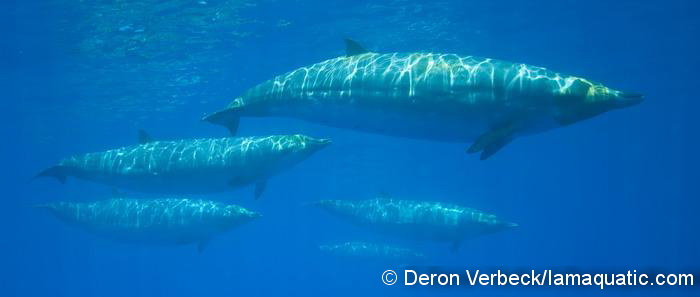

 Blainville’s beaked whales off the west coast of the island of Hawai‘i. Photo by Deron Verbeck/
Blainville’s beaked whales off the west coast of the island of Hawai‘i. Photo by Deron Verbeck/